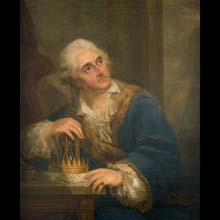
material: oil on canvas
dimensions: 62,5 x 50 cm
description: The signing of the partition treaty in Petersburg on January 23, 1793 between Russia and Prussia made Stanisław August Poniatowski aware of the approaching end of his rule. In February or March 1793, the king commissioned his court painter, Marcello Bacciarelli, to paint his allegorical portrait and gave the artist detailed instructions as to the way of portraying him. In the original picture, the king is looking through the window at the storm raging outside and the rays of sunshine falling from the sky. The attributes depicted in the painting emphasize the dramatic character of the scene: an hourglass standing inside the crown and a thunderbolt striking the ground symbolize the imminent end of his reign. A note of optimism is expressed in the words written by the king on the cards lying on the table: Quaesivit coelo lucem. Aen. IV. It is a fragment of a verse from book 4 of Aeneid by Virgil referring to dying Dido, which reads in its entirety as follows: ...oculisque errantibus alto | Quaesivit coelo lucem (“her dimmed eyes turned skyward, seeking the sweet light of day”) [source: Theodore C. Williams's Translation at the Perseus Digital Library. So the king orders his people to look for help in some unexpected coincidence, hoping for a miracle from heaven, which could save the country from final collapse. Two years later, after the fall of the Kościuszko Uprising, which had aimed to preserve the independence of the country, and after the Third Partition of Poland, which put an end to the existence of the state, the king abdicated in favour of Russia. Barbara Ciciora
exposition: The Gallery of 19th Century Polish Art in Sukiennice,
The Cloth Hall, 1, Main Market Square
key: Enlightenment >>>
dimensions: 62,5 x 50 cm
description: The signing of the partition treaty in Petersburg on January 23, 1793 between Russia and Prussia made Stanisław August Poniatowski aware of the approaching end of his rule. In February or March 1793, the king commissioned his court painter, Marcello Bacciarelli, to paint his allegorical portrait and gave the artist detailed instructions as to the way of portraying him. In the original picture, the king is looking through the window at the storm raging outside and the rays of sunshine falling from the sky. The attributes depicted in the painting emphasize the dramatic character of the scene: an hourglass standing inside the crown and a thunderbolt striking the ground symbolize the imminent end of his reign. A note of optimism is expressed in the words written by the king on the cards lying on the table: Quaesivit coelo lucem. Aen. IV. It is a fragment of a verse from book 4 of Aeneid by Virgil referring to dying Dido, which reads in its entirety as follows: ...oculisque errantibus alto | Quaesivit coelo lucem (“her dimmed eyes turned skyward, seeking the sweet light of day”) [source: Theodore C. Williams's Translation at the Perseus Digital Library. So the king orders his people to look for help in some unexpected coincidence, hoping for a miracle from heaven, which could save the country from final collapse. Two years later, after the fall of the Kościuszko Uprising, which had aimed to preserve the independence of the country, and after the Third Partition of Poland, which put an end to the existence of the state, the king abdicated in favour of Russia. Barbara Ciciora
exposition: The Gallery of 19th Century Polish Art in Sukiennice,
The Cloth Hall, 1, Main Market Square
key: Enlightenment >>>












